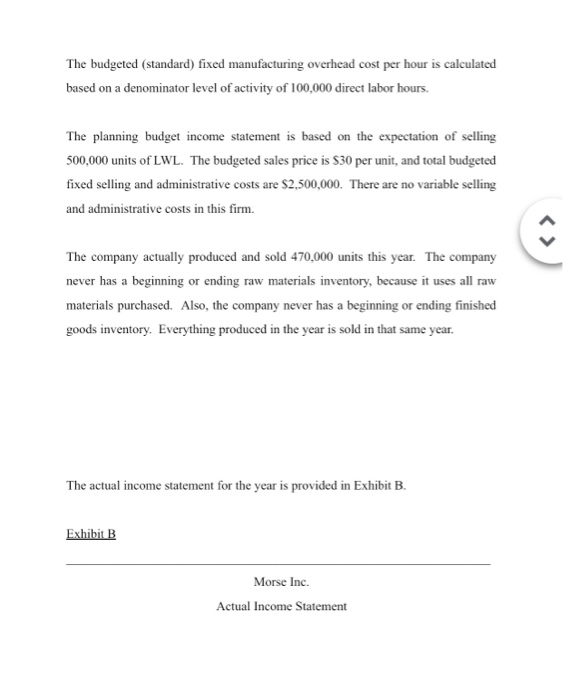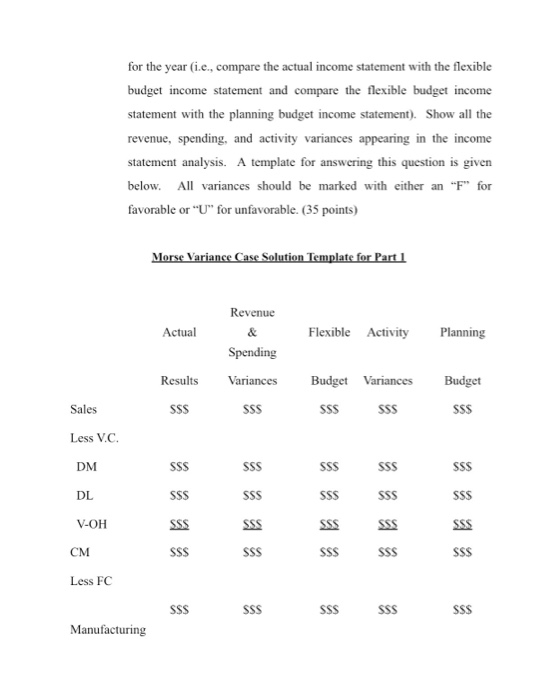Answered step by step
Verified Expert Solution
Question
1 Approved Answer
side note: i do not have any further information! this is all the information given for the case problem and i am not sure how





side note: i do not have any further information! this is all the information given for the case problem and i am not sure how else to specify
Morse VarianceCase Morse Inc. manufactures a single product, LWL. Morse uses budgets and standards in its planning and control functions. Morse makes use of its standards in order to derive their budgeted costs per unit. For example, Exhibit A provides information on the budgeted costs per unit. When determining direct material costs for the planning budget income statement, the S9 budgeted direct material cost per unit of LWL would be used in the calculation. Exhibita Budgeted (Standard) Costs Per Unit of LWL Direct materials: 3 pounds at S3 per pound Direct labor: 0.2 direct labor hours at $15 per hour Variable overhead: 0.2 direct labor hours at S10 per hour Fixed overhead: 0.2 direct labor hours at S20 per hour Total budgeted (standard) cost per unit of LWL The budgeted (standard) fixed manufacturing overhead cost per hour is calculated based on a denominator level of activity of 100,000 direct labor hours. The planning budget income statement is based on the expectation of selling 500,000 units of LWL. The budgeted sales price is $30 per unit, and total budgeted fixed selling and administrative costs are $2,500,000. There are no variable selling and administrative costs in this firm. The company actually produced and sold 470,000 units this year. The company never has a beginning or ending raw materials inventory, because it uses all raw materials purchased. Also, the company never has a beginning or ending finished goods inventory. Everything produced in the year is sold in that same year. The actual income statement for the year is provided in Exhibit B. Exhibit B Morse Inc. Actual Income Statement Sales: 470,000 units produced and sold at $32 $15,040,000 Less Variable Costs: Direct materials (1,316,000 pounds at $3.5 per pound) 4,606,000 Direct labor (117,500 direct labor hours at $10/hr.) 1,175,000 Variable manufacturing overhead 1.468.750 Contribution margin 7,790,250 Less Fixed Costs: Fixed manufacturing overhead costs 2,350,000 Fixed selling and administrative costs 2.360.000 Net operating income S 3.080.250 Required: Could you explain to your boss why the company should use the flexible budget income statement in the variance analysis? Your explanation should not be more than 1/2 page double spaced with a 12 font size. (15 points) 2. Prepare a detailed income statement variance analysis using the contribution approach income statement (i.c., variable costing basis) for the year (i.c., compare the actual income statement with the flexible budget income statement and compare the flexible budget income statement with the planning budget income statement). Show all the revenue, spending, and activity variances appearing in the income statement analysis. A template for answering this question is given below. All variances should be marked with either an "F" for favorable or "U" for unfavorable. (35 points) Morse Variance Case Solution Template for Part 1 Revenue Actual Flexible Activity Planning Spending Results Variances Budget Budget Variances SSSSSS Sales SSS SSS SSS Less V.C. DM DL V-OH CM Less FC Manufacturing Sell & Admin SSSSSSSSSSSSSSS NOI SSSSSS SSSSSSSSS Prepare a very detailed manufacturing cost variance analysis (e.g.. calculate the material price variance and quantity variance; the labor rate variance and efficiency variance; the variable overhead rate variance and efficiency variance; and the fixed manufacturing overhead budget variance and volume variance). All variances should be marked with either an "F" for favorable or "U" for unfavorable. Show your calculations. (40 points) Material Price Variance =( Could you reconcile spending variances in Part 2 with manufacturing cost variances in Part 3? For example, how is the amount of spending variance for direct materials in Part 2 explained by the amounts of direct material variances in Part 3? Excluding your quantitative analysis if any, your explanation should not be more than 1/3 page double spaced with a 12 font size. (10 points) Step by Step Solution
There are 3 Steps involved in it
Step: 1

Get Instant Access to Expert-Tailored Solutions
See step-by-step solutions with expert insights and AI powered tools for academic success
Step: 2

Step: 3

Ace Your Homework with AI
Get the answers you need in no time with our AI-driven, step-by-step assistance
Get Started


